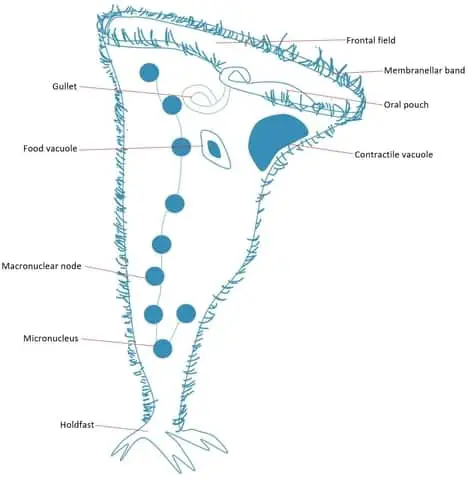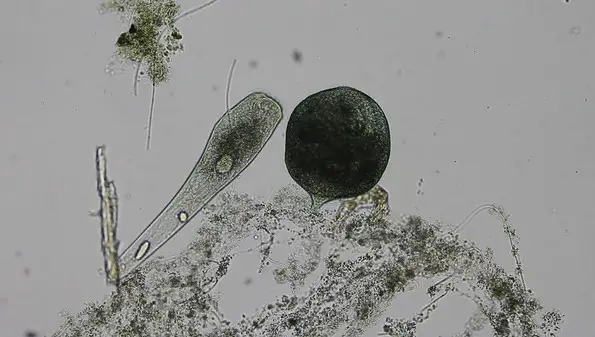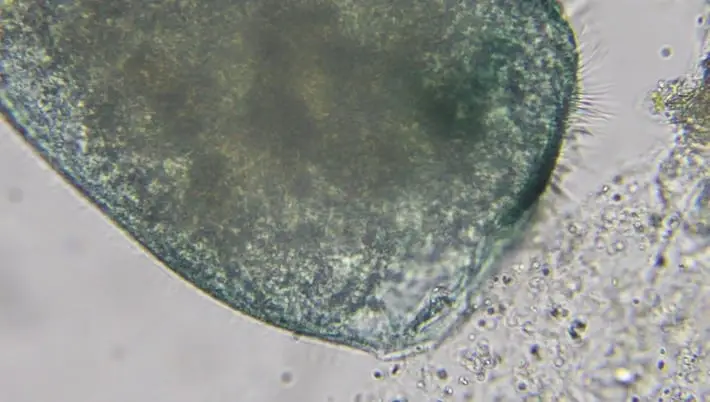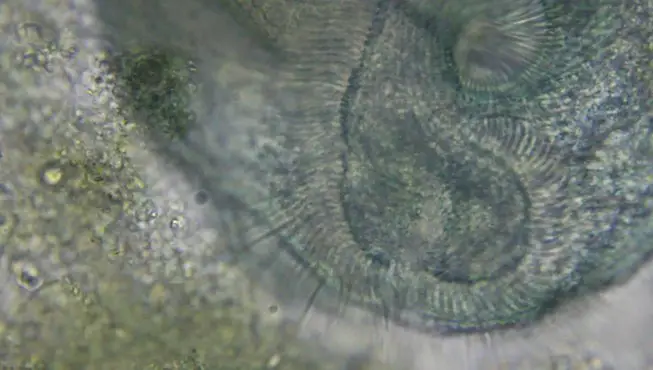Stentor is a genus of trumpet-shaped ciliates found primarily in stagnant fresh water. There are 22 known species of Stentor but there are most likely more that have yet to be discovered. Reaching a length of up to two millimeters, Stentor are amongst the largest known unicellular microorganisms. Although capable of swimming, it prefers to attach to a substrate using its holdfast (anchor) and extend to great lengths and then retract its body. Its regenerative properties and large size make it an ideal model organism for scientific inquiry.
Studying microorganisms such as Stentor for their amazing regenerative properties has helped shape modern medicine. Before observing these magnificent microorganisms, it is recommended to learn about them first so you can fully appreciate them. This article intends to help you gain a deeper understanding of the Stentor’s habitats, structures, and behaviors.
What is the Structure or Anatomy of Stentor?

Stentor are unicellular, meaning that they consist of only one large cell that is capable of carrying out all of the functions needed to sustain life. This large cell is capable of eating, digesting, excreting, breathing, and even reproducing all by itself. To understand how this is even possible, we must first understand its anatomy.
The organism relies heavily on hair-like structures called cilia for many of its critical functions. Cilia are found all over the body and provide two main functions which include the ability to move in unison to help the organism swim through water. It also helps move in a circular, and vibratory manner to pull water towards the mouth area. This helps attract food towards its gullet where bacteria and other food sources are filtered and ingested.
The many different variations of pigmentation seen in the Stentor are mainly attributed to the different types of algae ingested. They typically don’t eat algae for food, but instead, work together in symbiosis. The symbiotic relationship benefits the algae with safety and the Stentor with a food source. The algae also feed off of waste excrement from the Stentor and utilizes it for its own photosynthetic processes. This in turn produces nutrients for the Stentor.
The Stentor’s use of a contractile vacuole is another key feature. As the Stentor lives only in freshwater environments, the salinity content within is higher than that of its surrounding environment. This requires osmosis to take place in order to keep an equilibrium. Once the vacuole fills with water, it contracts and squeezes the water back out of the cell which keeps it balanced.
Let’s take a look at the Stentor’s physical structure next:

- Oral Cilia: Located at the anterior end of the cell, the oral cilia consistently pulsate which creates a vortex of water that pulls food towards its buccal cavity. The cilia further aid in filtering out and grabbing food sources such as bacteria as they pass by. Cilia are hair-like and protrusive organelles that are either motile or non-motile. Non-motile cilia serve primarily as sensory organelle whereas motile cilia can help the body of the cell move.
- Contractile Vacuole: The contractile vacuole is a specialized organelle that is found mainly in protists like the Stentor. This structure was touched on briefly above. A contractile vacuole can also help an organism move. Expelling water can act as a jet to propel an organism through the water. In the Stentor, it can be located just beneath the cell’s membrane. The scar-like features seen on the Stentor are actually vacuole pores.
- Buccal Cavity: A buccal cavity is a fancy way to say an organism’s mouth. It refers to the cheek cavity structure of an organism. The buccal cavity’s main function is to store and pass food along to the digestive system. The Stentor has an exceptionally large and prominent buccal cavity at the bell of its trumpet.
- Macronucleus: A macronucleus is a larger type of nucleus that is found mainly in ciliates. It stretches the entire length of the Stentor’s body and looks like a long strand of beads within the cell body. Macronuclei are polypoid and do not use mitosis to divide. The organelle is responsible for non-reproductive functions of the organism such as its metabolism. When conjugation occurs, the macronucleus actually disintegrates and a new one is formed. The macronucleus is somewhat of a mystery as it contains thousands of chromosomes but is incapable of partitioning itself during division.
- Cortical Stripes: The visible stripes on the Stentor are fibers that contain pigmented granules. When the wide stripes intersect with the narrow stripes, a feature called the locus of stripe contrast is formed. The color of the pigment depends on the kind of algae that the Stentor is eating or living symbiotically with.
- Holdfast: The holdfast, or the anchor, is the structure that allows the Stentor to attach to its substrate of choice. The anchor is strong enough to hold up the Stentor’s large body but too weak to withstand any significant flows of water. This is why Stentor are mainly found in stagnant or low-flow bodies of water.
How are Stentor Classified?

Stentor are classified as a Genus. Below is the full classification for stentor:
- Domain: Eukaryota – This Domain consists of the majority of the observable life that you’re familiar with, including plants, animals, fungi, algae, and protists. Each organism within this Domain possesses eukaryotic cells and a genome compartmentalized within a nucleus.
- Kingdom: Protista – Protista are just one of the five Kingdoms. Stentors are more commonly classified amongst an infrakingdom called the Alveolata and a subkingdom called the SAR supergroup.
- Subkingdom: SAR – The SAR supergroup is an acronym for a clade of Stramenopiles, Alveolata, and Rhizaria.
- Infrakingdom: Alveolata – This is a major clade of alveolates which represent a group of protists with body cavities. It’s an exclusive grouping with only two phyla beneath it. Defining characteristics of this clade include outer alveoli which are flattened vesicles that are layered on top of one another just beneath the membrane. It creates supports and also forms a thin skin that can form an armor-like plate. Ciliates are among the most common Alveolata.
- Phylum: Cilophora – (phylum of the ciliates) is a group of protozoans known best for their hair-like organelles known as cilia. It’s a strikingly similar structure to flagella but are generally shorter and occur in greater numbers.
- Class: Heterotrichea – A class of ciliates that have a distinctive membrane surrounding its mouth which may be used in either locomotion or feeding. The rest of the body is typically lined with a shorter cilia. Many of the organisms within this class are contractile and spend most of their time compressed or in a conical shape. Heterotrichea contains some of the largest protozoa, including Stentor and Spirostomum. Many species within this class are pigmented such as the blue Stentor coeruleus and the red Blepharisma.
- Order: Heterotrichida – The Order heterotrichida is best known for its large to very large-sized protists. Not only are the protists large, but they are highly contractile. The order is widely distributed, and the organisms are mostly free-living. Dense rows of cilia are present with undulating membranes.
- Family: Stentoridae – This family is recognized for its large size and ability to move freely. All Stentoridae have a trumpet-shaped buccal cavity region and have the ability to elongate and retract. They can be symbiotic by nature and are oftentimes pigmented.
- Genus: Stentor – The Stentor are horn-shaped organisms with a ring of cilia around its bell. They prefer to filter feed and spend their time attached to a substrate but do have the ability to swim thanks to their cilia. They are amongst the largest single-celled organisms on the planet. There are currently over 22 described species of Stentor.
What are the Most Common Types of Stentor?

There are only 22 known species of Stentor. Of those 22, the most prevalent species and their characteristics are listed below:
- Stentor amethystinus: Growing up to 1 millimeter in length, this species is found commonly in freshwater ponds and lakes. They live symbiotically with algae which provide food for the species. The Stentor that lines the algae adds a layer of protection in turn. Unlike many of the other species of Stentor, this species gives off a red or violet color due to a chemical called amethystin.
- Stentor coeruleus: Characterized by its giant size, this species can grow up to two millimeters when fully extended. It is known for possessing the largest ‘trumpet’ out of all species. A macronucelus within the Stentor is organized in a string of beads that are blue or bluish-green in color. The Stentor has the ability to contract down into a ball. It can also swim while fully extended or in a ball shape. This is one of the most commonly studied Stentor thanks to its regenerative abilities. When cut in half, it can regenerate so effectively that you cannot recognize where the incision was made.
- Stentor muelleri: This species is exceptionally long and can reach up to 3 millimeters in length. It’s found mainly in freshwater bodies but sometimes estuaries as well.
- Stentor roselii: A free-living version of the Stentor, this species is one of the most common and abundant Stentor in the world. It’s a colorless species without any pigmentation in its cortex. Cilia are organized in 40 to 80 longitudinal rows on the body.
| Stentor Species |
|---|
| Stentor amethystinus |
| Stentor coeruleus |
| Stentor muelleri |
| Stentor roselii |
| Stentor araucanus |
| Stentor baicalius |
| Stentor barrette |
| Stentor caudatus |
| Stentor cornutus |
| Stentor elegans |
| Stentor fuliginosus |
| Stentor igneus |
| Stentor introversus |
| Stentor katashimai |
| Stentor loricatus |
| Stentor magnus |
| Stentor multiformis |
| Stentor multimicronucleatus |
| Stentor niger |
| Stentor polymorphus |
| Stenro pyriformis |
| Stentor albus |
What do Stentor Eat?

Thanks to the large size of the Stentor, it can feed freely on just about any organism smaller than itself. Its large trumpet-shaped mouth allows for it to fit nearly all organisms smaller than it within its mouth. Stentor are so large that they have been observed eating multicellular organisms such as rotifers and water fleas.
The Stentor uses its cilia around its mouth to capture food and filter it. Water that enters through the mouth passes through and undergoes osmosis and exits back out the vacuole. If the Stentor cannot find food to its liking, then it is perfectly capable of detaching and moving to a new location to filter feed from. Although Stentor have the ability to eat multicellular organisms thanks to their size, they feed mainly on bacteria and other protozoans. However, Stentor have been known to be cannibalistic and eat their own species, but this has never been document on film.
Where do Stentor Live?
The habitat of the Stentor is mainly within freshwater bodies like lakes, ponds, puddles, and slow-moving creeks. They tend to avoid flowing water such as streams and turbulent areas because of their odd shape. Flowing water easily washes away the top-heavy and trumpet-shaped organism. Still or stagnant water is ideal for the Stentor to live within.
Since their diet consists mainly of bacteria, it makes sense that the Stentor prefers to live in stagnant water where bacteria are feeding on decomposing organic matter such as leaf litter. Even if Stentor could hold on and not be swept away by moving water, it’s unlikely that they would choose to stay living in moving water. Flowing water is troublesome for bacteria because decomposing organic matter washes away too quickly.
Regardless of flowing water, the Stentor will always choose to live closest to its beloved food source. Stentor are also commonly found near light sources which means that they are found in shallow water. This is due to their symbiotic relationship with algae. Since green algae are photosynthetic, they need to be near a light source to create energy for themselves.
How do Stentor Reproduce?
Stentor have two means of reproduction, conjugation, and binary fission. Stentor prefer to undergo binary fission unless the conditions are unfavorable. As discussed previously, the Stentor has a macronucleus which although holds genetic information, is incapable of aiding in reproduction. Instead, the Stentor relies on its micronucleus.
When two Stentor cross paths, the micronucleus replicates itself and the genetic information is exchanged. The exchanged information reorganizes and becomes a new macronuclei. Throughout the course of its life, the Stentor undergoes asexual reproduction multiple times before it is ready to sexually reproduce again.
Conjugation
Conjugation is a complex form of isogamy which is a form of sexual reproduction that is unique to unicellular organisms. As a unicellular organism, each and every organism is virtually identical in structure meaning that they generally cannot be classified as male or female. Instead of being referred to as male or female, they express + or – strains of DNA. Regardless, fertilization takes place and gametes of two separate organisms combine to form a zygote. It’s theorized that isogamy is ancestral to sexual reproduction as we know it today.
Binary Fission
Fission refers to the division of a single organism into two or more equal organisms that resemble or are identical to the parent. This is the preferred and most common form of reproduction amongst the Stentor. During this process, the DNA replicates within a micronucleus since the Stentor’s macronucleus does not assist in division.
The replicates scatter themselves throughout the cell’s membrane and begin to tear apart. As the membrane tears apart, half of the genetic material that is replicated and half of the genetic material that is original is separated. In this process, new cells are genetically identical.
How to Observe Stentor Under the Microscope

Stentor are massive microorganisms and their distinctive trumpet shape makes them very easy to spot. Stentor tend to be found near large accumulations of algae. So if you are looking for Stentor make sure when you take a sample there is plenty of algae. Larger stentor can even be seen without a microscope especially when they are fully elongated.
Stentor tend to move very slowly but most of the time they are anchored to microscopic debris, so it is very easy to use high magnifications to observe the minute details of these magnificent microorganisms. Aside from being very easy to observe their cyan color makes them one of the most beautiful microorganisms on the planet in my humble opinion.
When Were Stentor First Discovered?
The name of the Stentor comes from its trumpet shape and the herald in Greek mythology known for possessing a booming voice. The Stentor was first observed and documented in 1744 by Abraham Trembley. Abraham Trembley was a Genevan naturalist known for his work as it related to hydra. Trembley is credited as the father of zoology. Some go as far as calling him the father of biology.
Trembley thought he had discovered a new species in the hydra, but it was in fact first written about by Leeuwenhoek in 1702. In 1744, he published his groundbreaking book called Memoires pour server a l’histoire d’un genre de polypes d’eau douce. The book included the most detailed drawings and explanations of the hydra.
Within this groundbreaking novel was an excerpt about a large, trumpet-shaped ciliate that was thought to have been a hydra at the time. Trembley was unwittingly describing the Stentor and mistakenly grouping it with the hydra. It wasn’t until 1815 that the Stentor was revisited by German naturalist Lorenz Oken.
Lorenz Oken was a botanist, biologist, and ornithologist. He specialized in natural history and medicine. Oken established himself as the leader of the “Naturphilosophie’ movement in Germany when he began his series of work with a book titled Grundriss der Naturphilosophie, der Theorie der Sinne, mit der darauf gegrundeten Classificaton der Thiere in 1802. Oken was particularly fascinated by Stentor thanks to his background in medicine.
In fact, Oken was a professor of medical sciences at the University of Jena for a short while. Stentor, like hydra, have amazing regenerative properties that fascinated Oken. He recognized that Stentor should not be classified as hydra based on sensory organs and helped reclassify them and push them into mainstream science.
References
- https://owlcation.com/stem/Stentor-A-Trumpet-Shaped-Organism-With-Interesting-Behaviour
- https://study.com/academy/lesson/stentor-protist-reproduction-anatomy-habitat.html
- https://www.canadiannaturephotographer.com/stentor.html
- https://www.sciencedirect.com/topics/agricultural-and-biological-sciences/ciliophora
- http://species-identification.org/species.php?species_group=zsao&id=213&menuentry=groepen
- http://species-identification.org/species.php?species_group=zsao&id=217&menuentry=groepen
- https://www.researchgate.net/figure/A-descriptive-diagram-of-Stentor-coeruleus-All-of-the-features-shown-are-on-the-cell_fig3_233929863
- http://www.madsci.org/posts/archives/2000-11/975558285.Cb.r.html
- https://www.cell.com/current-biology/pdf/S0960-9822(14)00760-X.pdf

